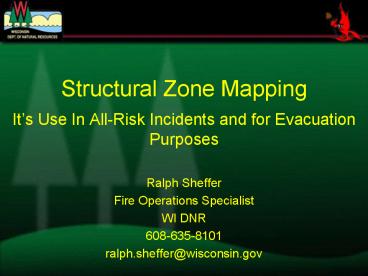Structural Zone Mapping - PowerPoint PPT Presentation
1 / 30
Title:
Structural Zone Mapping
Description:
Miscellaneous maps (county major road map, emergency districts, etc. ... road index including. Road. Address range. Township. Page number. GIS Maps/Databases ... – PowerPoint PPT presentation
Number of Views:64
Avg rating:3.0/5.0
Title: Structural Zone Mapping
1
Structural Zone Mapping
- Its Use In All-Risk Incidents and for Evacuation
Purposes - Ralph Sheffer
- Fire Operations Specialist
- WI DNR
- 608-635-8101
- ralph.sheffer_at_wisconsin.gov
2
Zone Mapping What is it?
- Takes mapping of structural locations and breaks
them into manageable units (Zones).
3
GIS mapping created and maintained from County
Land Information database
4
- Kept in 3 Forms
- Book in every emergency vehicle (extras for
ICP/EOC) - PDF computer format
- GIS Mapping Layers (ArcView)
5
Book Setup
- Currently there are a wide variety of setups
across the state. - DNR is working to establish recommended minimum
standards. - Page size 11 x 17
6
Overview map
- Shows entire county with townships delineated
with page the township is on.
7
Zone page/structural page pairs.
- Structure Location
- Zone boundaries
- County, township, section boundaries
- Roads
- Rivers, streams, lakes
- Water Points
- Railroads, pipelines, power lines
- Map Legend
- Zone legend
- Color coded zone name
- Number of addresses in zone
8
Full county zone index
9
Structure Location
- At minimum, the structure point should be
geo-coded (address matched) along the buildings
address road. - Ideally the structure location should be a point
at the actual structure with an accompanying line
from structure along driveway to main road access
point for driveways over 200. - On each page, with the legend, a small text note
should briefly indicate how the structure
location was determined (i.e. GPS, Geo-coded,
etc.)
10
Zone Boundaries
- All structures should be within a zone.
- Limit should equal approximately 20 addresses per
zone. - Zones should connect so there are no un-zoned
gaps on a road. - Zones should follow the shape of the road as much
as possible, but reach out away from the road far
enough to included isolated structures. - If a structure is at an intersection where 2 or
more zones meet, if possible, it should be put in
the zone on the road named in its address.
11
Optional
- Miscellaneous maps (county major road map,
emergency districts, etc. - Other indices may be included as deemed
beneficial - i.e.. County road index including
- Road
- Address range
- Township
- Page number
12
GIS Maps/Databases
- Structural database maintained by County Land
Information. - Zone layer maintained by DNR in areas of state
that fall under DNR protection. - Can be utilized at an ICP/EOC.
- Can hold more information than what map books can
hold.
13
Information can be tied to GIS point
Columbia County
14
Adams County
15
Other info can be in database
- Hazardous materials permitted storage areas.
- Digital photo of structure.
- Tax parcel information.
- Anything else you may need/want.
16
Can be used for fire
17
Tornado
Above Stoughton tornado 2005, Dane Co. Right
Easton tornado 2004, Adams Co.
18
Flooding
Above Wyocena dam 2004, Columbia Co. Right
Randolph flooding 2004, Columbia Co.
19
HAZMAT
Left Weyauwega train derailment 1996, Waupaca
Co. Right Watertown tire fire 2005, Dodge Co.
20
Other potential uses
- Large area search and rescue (Wood County 2007).
- WMD/terrorist effected areas.
- Crowd control.
- Planned events (Ironman race, Summerfest, ESPN
Games, etc). - ERT/SWAT efforts (Virginia Tech, Beverly Hills
(?) robbery) - Anything that effects a few city/village blocks
up to multiple counties.
21
One of the keys to a successfully run incident is
organization
22
Evacuation
- How do you organize and track evacuation
- in a large urban area?
23
Evacuation
- Or in an area that is 7 miles long and over 1
mile wide?
24
Zone Mapping
- Zone maps help organize resources by giving them
a specific area to concentrate on. - Reduces duplication of efforts.
25
Zone Mapping
- Zone maps provide resources with number and
location of addresses in their area of
responsibility.
26
Zone Mapping
- Zone maps can be used to delineate areas of
evacuation for a Reverse 911 system.
27
Where Do We Have Maps?
28
What does it take?
- Time
- - Potential federal grant funding (Hazard
mitigation grant) in areas under DNR protection. - Cooperation between departments
- Emergency Management
- County Sheriffs Dept.
- County Land Information
- County Zoning
- WI DNR
- Support from supervisors.
29
Updating
- County Land Information updates the database
continually as new houses/businesses are built. - Recommended to print new map books every 5 years.
- Sooner if major changes are made.
30
Questions?
- Ralph Sheffer
- WI Dept. of Natural Resources
- W7303 CTH CS
- Poynette, WI 53955
- 608-635-8101
- ralph.sheffer_at_wisconsin.gov































